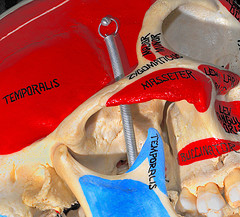External Pterygoid
External Pterygoid- Properties (Revision)
The external (lateral) pterygoidmuscle appears as a short thick muscle. Arises two heads, the lower part of the lateral surface of the great wing of the sphenoid and from the infratemporal crest. The lower head occurs from the lateral surface of the lateral pterygoid plate. The fibres of this muscle are related to its function, as they run horizontally backwards and lateral wards. Both heads insert at the condyle of the mandible, front margin of the articular disk of the Temporo-mandibular articulation.
Action of the pterygoid muscles:
- Elevates the mandible
- Closes the jaw
- Helps in side to side movement of the jaw. (figure of∞ movement)
If the pterygoid muscles (internal and external) of one side act, the corresponding side is drawn forward; the opposite condyle remains relatively fixed. Allowing for side to side movements of the mandible. This occurs during trituration.
Action
The external pterygoid muscles assist in the opening of the mouth. Detailed description of the action of this muscle would be as the muscle contracts the condyle process is drawn forward and the articular disk protrudes the mandible so that the inferior incisors project in front of the superior incisors. The action of the external pterygoid muscle is to protrude the mandible and open the mouth. The superior portion of the external pterygoid tenses during clenching.
Image courtesy of https://www.flickr.com/photos/8614098@N03/2141463830/ under the creative commons license.
Origin/Insertion
 External Pterygoid muscle, the inferior head originates from the pterygoid process and is inserted to the mandible. The superior head originates at the sphenoid bone and is inserted to the articular disc. The external pterygoid muscle is the only muscle to open the jaw out of the four main muscles of mastication. The action of the lateral pterygoid is that it depresses the mandible and protrudes the mandible forward thus opening the jaw. The innervations for the external pterygoid muscle include a pterygoid branch of the CNV.
External Pterygoid muscle, the inferior head originates from the pterygoid process and is inserted to the mandible. The superior head originates at the sphenoid bone and is inserted to the articular disc. The external pterygoid muscle is the only muscle to open the jaw out of the four main muscles of mastication. The action of the lateral pterygoid is that it depresses the mandible and protrudes the mandible forward thus opening the jaw. The innervations for the external pterygoid muscle include a pterygoid branch of the CNV.
